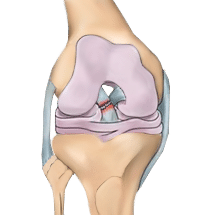What is an ACL?
The anterior cruciate ligament (ACL) is located in the central part of the knee, inside of your knee joint. These ligaments control the back and forth movements of your knee.
The function of the ACL is to protect against excessive motion at the knee joint. Therefore, preventing the tibia from sliding out in front of the femur. Additionally, it provides rotational stability to the knee.
ACL Injury

An ACL injury is a tear or sprain of the anterior cruciate ligament. This type of injury usually occurs in sports due to sudden stops or changes in direction.
An ACL injury most commonly occurs from a sports injury, such as:
- soccer
- basketball
- football
- downhill skiing
When an ACL injury occurs, there is typically a pop-like sound in the knee. Your knee may feel unstable, and swelling is possible. In some instances, it may become too painful to bear weight.
About half of all injuries to the anterior cruciate ligament occur along with damage to other structures in the knee, such as articular cartilage, meniscus, or other ligaments.
Symptoms of an ACL Injury
The signs and symptoms of an ACL injury include the following:
- A loud “pop” or a “popping” sensation in the knee.
- Severe pain and inability to continue being active.
- Rapid swelling.
- A feeling of instability or “giving way” with weight-bearing.
- Loss of range of motion.
Also, see: 4 Ways to Identify a Possible ACL Knee Injury
ACL Injury Causes
ACL Injuries often occur during sports and fitness activities, when stress is placed on the knee.
Several risk factors increase your risk of an injury. Which include the following:
- Sex: Being female.
- Playing sports: Participating in sports such as soccer, football, basketball, gymnastics, and downhill skiing puts you at risk.
- Weightlifting: Improper form could put you at risk for an injury when working out.
- Improper footwear: Footwear that does not fit properly.
- Poorly maintained equipment.
ACL Injury Treatment
In the case of a partial tear or acute isolated injury to the ACL, conservative management should be the first-line of treatment.
Non-Surgical:
When treating an injury such as this one, x-rays, an MRI, or ultrasound are typical. Therefore, allowing the doctor to see the severity of the tear.
Additionally, treatments may include physical therapy, anti-inflammatory medications, bracing, and possibly corticosteroid injections. These non-surgical options are likely effective in managing symptoms.
It’s typical for your physician to put you on bed rest with ice, compression, and elevation to reduce the swelling.
Surgery:
If significant laxity occurs with mechanical symptoms or failure of conservative management, surgical treatment is necessary. Surgical intervention will help restore function and mobility and promote a return to activity.
ACL Reconstruction. During this surgical procedure, they remove the ligament and replace it with a segment of a tendon. Next, the surgeon will take a piece of tendon from another part of your knee and replace it.
After surgery, physical therapy is necessary to regain the stability and function of your knee.
